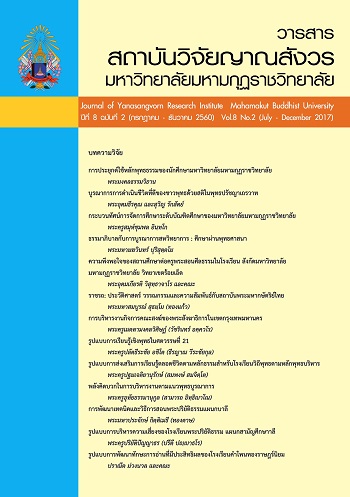The Effects of Program a Development of Ability in Creative Problem Solving of Mattayomsuksa 3 Students in Pramoch Vittaya Ramintra School
Main Article Content
Abstract
The purpose of the research were 1) study the level of ability in creative problem solving of mattayomsuksa 3 students, and 2) to compare the ability in creative problem solving of the students before and after participation in the program a development of ability in creative problem solving. The sample in this research were 30 students in mattayomsuksa 3, in the semester of the 2017 academic year at Pramoch Vittaya Ramintra School, selected by using cluster sampling. The experimental design was pattern a One Group Pretest-Posttest Design. The research instruments were the ability in creative problem solving test and the program a development of ability in creative problem solving. The data were analyzed by using mean, standard deviation and t-test for dependent sample. The results of the study were as follows: 1. The scores of ability in creative problem solving of the students before participation in the program a development of ability in creative problem solving was middle and after participation in the program a development of ability in creative problem solving of the students was higher. 2. The ability in creative problem solving of the students increased after participationin the program a development of ability in creative problem solving and significant at .05 level
Article Details
References
นิพิฐพร โกมลกิติศักดิ์. (2553). การวิเคราะห์ผลของกระบวนการแก้ปัญหาเชิงสร้างสรรค์ที่มีต่อความสามารถในการแก้ปัญหาเชิงสร้างสรรค์ทักษะการทำงานกลุ่มและการเห็นคุณค่าในตนเองของนักเรียนมัธยมศึกษาตอนต้น : การทดลองแบบอนุกรมเวลา. วิทยานิพนธ์ ครุศาสตรมหาบัณฑิต บัณฑิตวิทยาลัย จุฬาลงกรณ์มหาวิทยาลัย.
นันทนัช ตนบุญ. (2553). การใช้ เอส ที ไอ เอ็ม เพื่อพัฒนาความสามารถในการเขียนภาษาอังกฤษ เชิงสร้างสรรค์และการแก้ป้ญหาเชิงสร้างสรรค์ของนักเรียนชั้น มัธยมศึกษาปีที่ 5. ปริญญานิพนธ์ศึกษาศาสตรมหาบัณฑิต (การสอนภาษาอังกฤษ) บัณฑิตศึกษา มหาวิทยาลัยเชียงใหม่.
ประณต เค้าฉิม. (2554). การเรียนรู้และการจำ. กรุงเทพฯ: สาขาวิชาจิตวิทยา คณะจิตวิทยามหาวิทยาลัยเกษมบัณฑิต. ถ่ายเอกสาร.
พาสนา จุลรัตน์. (2548). จิตวิทยาการศึกษา. กรุงเทพฯ: ภาควิชาการแนะแนวและจิตวิทยาการศึกษา คณะศึกษาศาสตร์ มหาวิทยาลัยศรีนครินทรวิโรฒ. ถ่ายเอกสาร.
พัชรา พุ่มเพชาติ. (2552). การพัฒนารูปแบบการจัดประสบการณ์การแก้ปัญหาอย่างสร้างสรรค์สำหรับเด็กปฐมวัย. วิทยานิพนธ์ปริญญาปรัชญาดุษฎีบัณฑิต สาขาหลักสูตรและการสอน บัณฑิตวิทยาลัย มหาวิทยาลัยศิลปากร.
ภาวินี บุญธิมา. (2553). การจัดกิจกรรมแนะแนวด้วยเทคนิคการคิดแก้ปัญหาอนาคตตามแนวคิดของทอร์แรนซ์เพื่อส่งเสริมความสามารถในการคิดแก้ปัญหาอย่างสร้างสรรค์ของนักเรียนชั้นมัธยมศึกษาปีที่ 4. ปริญญานิพนธ์ศึกษาศาสตรมหาบัณฑิต (จิตวิทยาการศึกษาและการแนะแนว) บัณฑิตศึกษา มหาวิทยาลัยเชียงใหม่.
ศิริพร แก้วอ่อน. (2557). การพัฒนาความสามารถและเจตคติในการแก้ปัญหาอย่างสร้างสรรค์ของนักเรียนชั้นมัธยมศึกษาตอนปลายในโครงการห้องเรียนพิเศษวิทยาศาสตร์. ปริญญาวิทยาศาสตรมหาบัณฑิต (สาขาวิชาการวิจัยพฤติกรรมศาสตร์ประยุกต์). กรุงเทพฯ : บัณฑิตวิทยาลัย มหาวิทยาลัยศรีนครินทรวิโรฒ.
สรวงสุดา ปานสกุล. (2545). การนำเสนอรูปแบบการเรียนรู้กระบวนการแก้ปัญหาเชิงสร้างสรรค์แบบร่วมมือในองค์กรบนอินเทอร์เน็ต. วิทยานิพนธ์ปริญญาดุษฎีบัณฑิต. สาขาวิชาเทคโนโลยีและสื่อสารการศึกษา คณะครุศาสตร์ จุฬาลงกรณ์มหาวิทยาลัย.
อารีย์ พันธ์มณี. (2546). จิตวิทยาสร้างสรรค์การเรียนการสอน. กรุงเทพฯ: ใยไหมเอดดูเคท
Berk, L.E. and Winsler, A. (1995). A Scaffolding Children’s Learning : Vygotsky Early Childhood Education. Boston : Seven street studio.
Osborn, A. F. Applied the imagination : principles and procedures of creative thinking. New York : Scribner, 1957.
Parnes, S. J. Creative Behavior Guide Book. New York : Charles Scribner’s Son, 1967.
Passer, Michael W.; &Smith, Ronald E. (2007).Psychology: The Science of Mind and Behavior.Third Edition. New York: McGraw-Hill
Treffinger, D. J., Isaksen, S. G., & Firestien, r. L. (1983). Theoretical perspectives on creative learning and its facilitation: An overview. Journal of Creative Behavior, 17(1), 9-17.
Treffinger, D.J. Creative Problem Solving : overview and educational implications. Educational Psychology Review. 7 (September 1995) : 301-312.
Treffinger, J.D., Isaksen, G. S and Dorval, K.B. (2003).Creative problem solving (Cps version 6.1) A contemporary framework for managing change. Journal of Creative Problem Solving Group.[Online]. Available from http://cps com [2014,October 9].
Treffinger, D. J., Isaksen, S. G., & Dorval, K. B. (2003). Creative problem solving (CPS Version 6.1) A contemporary framework for managing change

